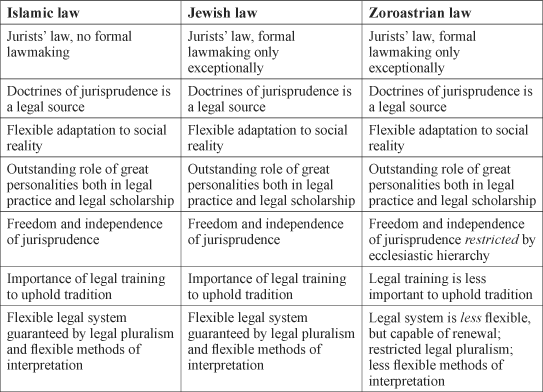Conclusions: Lessons in Legal Sociology

Chapter 7 Despite theological postulations and claims of legal theories Islamic, Jewish and Zoroastrian laws are jurists’ law irrespective of the fact that the foundations of these legal systems were laid down in holy books (the Bible, the Qur’ān and the Awesta). Fiqh law is a jurists’ law established by mujtahids. Post-biblical Jewish law is also jurists’ law, blossomed in the intellectual centres of the Palestinian and Babylonian Academies. The situation is similar in Zoroastrian law, with the significant difference that the rules of the Awesta put less emphasis on everyday legal practice than those of the Qur’ān and the Bible. All three legal systems witnessed a transformation from customary law to ‘religious law’ by the subsequent theologization of existing norms. This process was linked to one person in Jewish and Islamic law despite the fact that it was a long process stimulated by different social and historical circumstances, while in Zoroastrian law such a person was missing. This conceptualization prevented political authorities from interfering in the realm of the law by lawmaking which was substituted by the law-finding activity of legal scholars. Therefore the efficiency of these legal systems depended on the quality of jurisprudence. This primacy of jurisprudence cannot be compared to the position of Roman legal scholars whose interpretative activities only supplemented but did not substitute legislation. By contrast, in the legal systems studied here state legislation was absent and new rules were ‘discovered’ (that is, established) by legal scholars primarily on a case-by-case basis, through solutions of particular ‘hard cases’ and not as a result of broad-scale legal reforms. Since legal scholars were at the same time active in everyday legal practice as judges and legal consultants, new doctrines defined by them rested on their practice and were supported by scholarly reasoning. Consequently, ‘lawmaking’ and legal practice were not separate but intertwined, which resulted in a flexible understanding of law. This flexible attitude to law is proven by the fact that various legal doctrines were formulated on social practice, and were sometimes adjusted to the demands of the respective societies. All this could not have been achieved without great personalities; moreover, the entire system was built on them. This is the reason why such great emphasis was laid on the qualification of legal scholars and judges and on legal education, during which not only already established legal norms but also legal theory, grammar and the techniques of interpretation were studied. Besides learning by heart, scholarly disputes were important during the course of education, aimed at preparing students for constant legal debates inside the courts and among legal scholars. The ultimate end of these debates was to establish legal rules but they rarely resulted in a full agreement. Therefore, majority rule as an auxiliary mechanism was introduced in Jewish law but Islamic law insisted on consensus. By contrast, in Zoroastrian law – where ecclesiastic hierarchy reduced scholarly debates – the autonomy of jurisprudence was narrowed. The creativity of great personalities, a relatively free finding of law in the texts and the subsequent scholarly debates were the main factors which contributed to legal pluralism present in all three legal cultures. This legal pluralism was manifest both horizontally and vertically: horizontally among the various schools; vertically within the schools among scholars belonging to them. Taken as a whole, Islamic and Jewish legal systems are more pluralistic than Zoroastrian law in two important aspects. First, on the level of legal doctrines: in both Islamic and Jewish legal systems legal schools were developed with their own doctrines and methods, a fragmentation of utmost importance for Islamic law even today. By contrast, there are no such entities in Zoroastrian law – only legal debates on some irrelevant problems of ritual law which remained on an academic level but did not result in madhhab-like entities. Second, if legal pluralism is taken as an opportunity for ‘forum-shopping’ (a term recently introduced by Ido Shahar),1 – that is, litigants could choose from among a variety of legal forums where to turn – it is again Islamic and Jewish law which is more pluralistic. In the Islamic context a litigant could turn to the qāḍī, the maẓālim court, but could also rely on arbitration. In Jewish law, too, there are several forums at the disposal of the litigants: beside the rabbinic court one could turn to arbitrators, lay judges and to the Roman or Muslim courts, depending on historical circumstances. By contrast, in Sasanian Persia the competencies of the courts, rads and mōbeds
Conclusions: Lessons in Legal Sociology